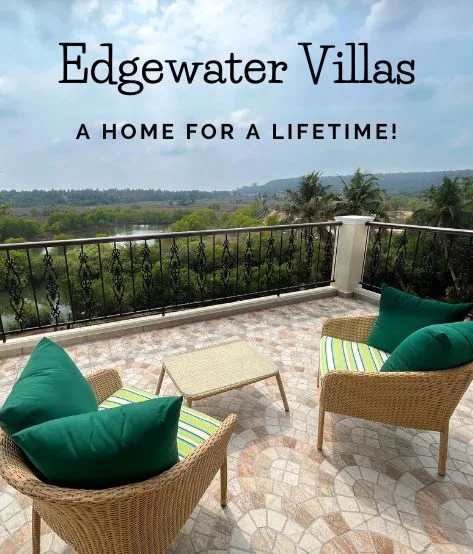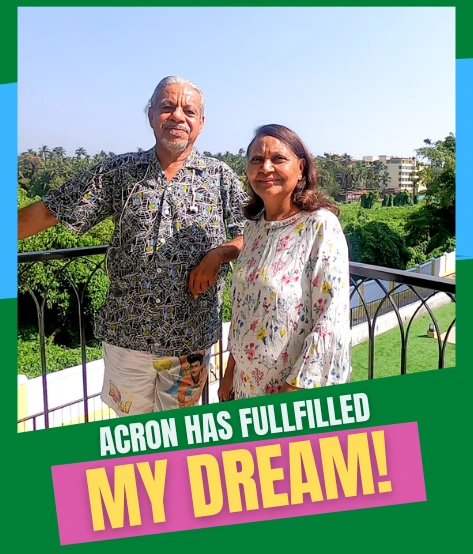With the Portuguese rule for over 450 years and the influence of Portuguese culture, Goa portrays a different and somewhat more architecturally unified picture to the foreign visitor than other parts of the country. Goa’s Portuguese-style bungalow mansion is likely the most iconic architectural form there is. Most were built in the early 18th century as a form of payment and gratitude to officials and wealthy Goan merchants for their services to the Portuguese. The beautiful tiles with their patterns and creative design elaborate how much effort and care we used to invest in our homes. We used to be creative in minute details. One developer in Goa hopes to help recreate that style of architecture and incorporate all the modern amenities that one could ask for in a Luxury Villa in Goa.
Acron Developers have been Goa’s most trusted developer for over 28 years and they know a thing or two about building a house and making it a home. Perched quietly on hill sides and in valleys, the Houses of Goa draw beauty from their surroundings. The flora and fauna become part of the homely experience and one feels intense joy and relaxation to wake up to the sounds of a variety of birds, harmoniously singing together. It is in this very setting that the house displays its wonder. As the light peaks through the tiled roofs, the essence of a fresh day in paradise resonates through these homes. Sunlight and its warmth was an important feature of the Goan house. The windows were large and mostly kept open, so as to let the maximum amount of sunlight in. Every Acron Home keeps these design concepts in mind with large windows that also serve another purpose as they help reduce the cost of artificial lighting that would be required. Another interesting feature that Acron has contributed to the incorporation of sunlight in the house are the various types of sun-roofs and 360 degree view attics. These are large open spaces with beautiful views and are very much part of the home.
In the original Portuguese plans the construction was mostly rectangular with the front facade all in one plane. To balance this horizontal effect, pilasters were used to add a vertical emphasis. Acron Developers have stuck to the original style of building and modified the surroundings to incorporate a lot more features, such as a car park and separate entries for semi-detached villas, in a way that balances out the final look of the home. They have even gone so far as to add miniature waterfalls for certain projects.
As one travels around Goa you can see that a prominent feature is also the gate post and gateways that crave attention. These architectural features perform an ambiguous function, that of drawing your attention to the house within and intimidating you from entering without permission. Each of Acron’s Developments are well gated and secure communities with round the clock surveillance and have a prestigious looking entrance that make you ogle at the beautiful homes inside.
Another interesting thing to notice is the use of pillars. Now after much observation, one can come to conclude that there is no specific style that influences the majority of pillars used in Goan houses, they can range from simple masonry to elaborate works of art. The architects at Acron came up with some interesting ways of finding a balance between the two and even used them inside some of the homes to give it a very royal and majestic feel. It’s important to remember that the Portuguese were master builders when it came to their homes. Many of them have stood the test of time, as have all their other structures, Churches, river crossings even some roads still remain. Portuguese architecture has inspired so much in the state of Goa that every 'Goa enthusiast' longs to have their "Goan Villas" resemble the Portuguese style of construction.
A prime feature in every Goan house was the balcao. It could be described as a porch with seats built into the sides. It is a kind of open hall, a device for the Goan to open up to the world. The climatic conditions in Goa aided to the metamorphosis of the balcao into a wide veranda that ran along the front and sometimes the sides of the house. There, people would meet and sit, as they spoke about the world and were one with it.Acron homes incorporate this feature in creative ways, getting that symmetry just right when it comes to houses on flat land and even on slopes.
In Goa colour as a tradition dictated that private homes paid respect to houses of worship by refraining from bearing the same distinctive whiteness. The code dictated that no private house could be painted white. An average Goan home is recognized by the colour of its walls which stay unforgettably vivid in one’s memory. As you walk down the pathway at any one of their many developments in Goa, you can see the way Acron has maintained the rich cultural heritage in terms of the colour schemes and architectural elements in their homes, all that along with lush gardens, crystal clear swimming pools surrounded by green forests. Their latest villa project, Acron Uplands is on a smooth sloping hillside in Nachinola, near Moira and has semi-detached and independent villas with a gymnasium, pool and kids play area, all spread over a charming two acre property.
Many people who are world travellers or those who simply have second homes in different places of the world wish to incorporate some sort of cultural influence into their Luxury Villa or Apartment. In Goa some of the best kept and beautiful homes are those that resemble the land’s culture.
As a closing note, if ever you are in Goa and want to make this place your home with a luxury villa, it’s worth the time to check out their Goa residential projects, and maybe even book your dream home in paradise.




